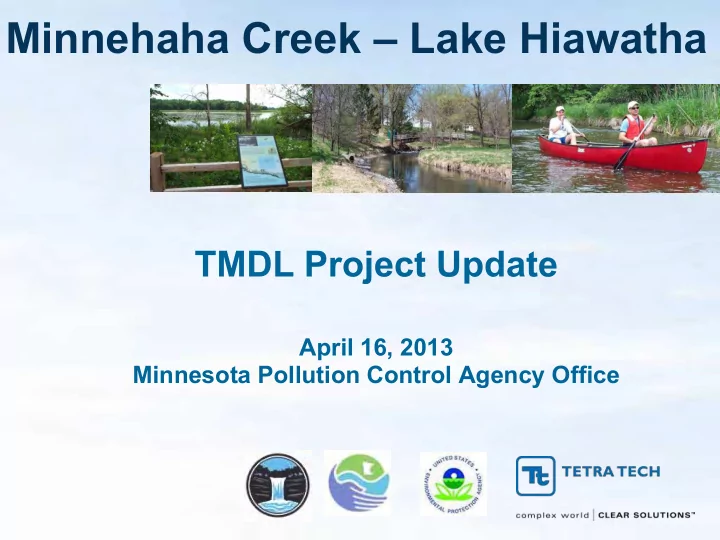

Minnehaha Creek – Lake Hiawatha TMDL Project Update April 16, 2013 Minnesota Pollution Control Agency Office
Minnehaha Creek TMDL Discussion Overview Draft TMDL Report Quick overview Allocations Bacteria Total phosphorus Implementation BMP Targeting
TMDL Development Data Driven Approach Figure 3-1
Data Driven Approach Quick “Re - Cap” Bacteria Figure 3-2
Data Driven Approach Quick “Re - Cap” Total Phosphorus Figure 3-3
TMDL Targets Reduction Needs Table 3-3 2001-2011 Parameter Target Reduction Average E. coli (#/100mL) 301 1 126 58.1% Total Phosphorus (µg/L) 70.9 2 50 29.5% 1 Average values reflect April- Oct. geometric mean, Notes: consistent with WQS. 2 Value reflects growing season average (June-Sept), consistent with site-specific criteria.
Linkage Analysis Bacteria Loading & Response Figure 5-13
Linkage Analysis Reduction Needs Bacteria Table 5-5 Group High Moist Mid Dry Low --- Grays Bay --- --- --- --- --- A McGinty --- --- --- --- --- B W. 34th --- --- --- 25% 4% C Excelsior 12% 35% 55% 76% 45% D Browndale --- --- --- --- --- E Browndale to Chain of Lakes 19% 32% 16% 46% 47% F Chain of Lakes to Lake Hiawatha 40% 54% 58% 73% 68% H Lake Hiawatha to mouth 30% 12% --- 15% 6%
TMDL Development Bacteria Allocations Overall Target Set at watershed outlet Duration curve framework Categorical Allocation WLA assigned to all MS4s MnDOT has individual WLA Explicit “Margin of Safety”
TMDL Development Bacteria Allocations Summary Table 6-2 Duration Curve Zone High Moist Mid Dry Low L OADING C APACITY 857 412 153 41.0 13.7 WLA -- T OTAL 610.0 295.7 107.8 28.77 8.23 Categorical MS4 WLA 285.1 103.9 27.74 7.94 588.2 Mn DOT MS4 WLA 21.8 10.6 3.9 1.03 0.29 LA -- T OTAL 161.3 75.1 29.9 8.13 4.10 Non-MS4 stormwater 129.3 62.7 22.9 6.10 1.74 Upstream Boundary 12.4 7.0 32.0 2.03 2.36 Margin of Safety (10%) 85.7 41.2 15.3 4.10 1.37
Linkage Analysis Watershed Loading Phosphorus Figure 5-14 Watershed Estimates
Linkage Analysis Phosphorus Loading Unit Area Loads + Other Sources Table 5-6 Area Rate Seasonal Cumulative Group (acres) (lbs/acre) (pounds) (pounds) --- Grays Bay --- --- 1,279 1,279 A McGinty 3,494 0.260 908 2,187 B W. 34th 5,103 0.163 827 3,014 C Excelsior 1,998 0.500 1,033 4,047 D Browndale 1,427 0.378 539 4,586 E BD to COL 2,172 0.378 821 5,407 F COL to LH 2,504 0.283 709 6,116 G LH Direct 1,195 0.283 347 6,463
Linkage Analysis Existing Phosphorus Loads Summary of Table 5-9 Subwatershed Group Load (pounds per growing season) A/B C D E F G Upstream MS4 Stormwater 1,141.2 904.3 490.9 791.0 690.3 337.6 Wastewater Facilities 33.8 4.6 Non-MS4 Stormwater 593.8 94.9 48.1 30.0 18.7 0.7 Atmospheric 4.1 Upstream 1,279 T OTAL E XISTING 1,279 1,735 1,033 539 821 709 347
MLCCS Data Figure 2-3 Non-MS4 stormwater estimates Combination approach WLAs
TMDL Development Phosphorus Loading Capacity Determination Table 6-3 Site Reduction Needs Total 2001-2011 Loading Specific Phosphorus Average Capacity Percent TP Criteria (70.9-50) Concentration 50 70.9 70.9 (μg/L) 29.5% = Load 6,463 1,907 4,556 (pounds/season)
TMDL Development Phosphorus Reduction 1,907 pounds Figure 6-1
Phosphorus Allocations Methods Considered Equal Percent Reduction Area Export Coefficient Impervious Cover “Combination” Approach
Phosphorus Allocations Summary Consolidated Table 6-5 Subwatershed Group Load (pounds per growing season) A/B C D E F G Upstream MS4 Stormwater 911 349.6 228.9 426.4 508.5 244.3 Wastewater Facilities 33.8 4.6 Non-MS4 Stormwater 474 38.8 22.4 16.2 13.8 0.5 Atmospheric 4.1 Upstream 1,279 T OTAL A LLOCATIONS 1,279 1,385 422.2 251.3 442.6 522.3 253.5 T OTAL E XISTING 1,279 1,735 1,033 539 821 709 347
Phosphorus Reductions Group Summary Combined Summary of Table 5-9 and Table 6-5 Subwatershed Group Load (pounds per growing season) A/B C D E F G Existing 1,141.2 904.3 490.9 791.0 690.3 337.6 MS4 Stormwater Allocation 911.0 349.6 228.9 426.4 508.5 244.3 Reduction 20% 60% 53% 46% 26% 28% Existing 593.8 94.9 48.1 30.0 18.7 0.7 Non-MS4 Stormwater Allocation 474.8 38.8 22.4 16.2 13.8 0.5 Reduction 20% 60% 53% 46% 26% 28%
Phosphorus Allocations Summary Table 6-6 Total Phosphorus Load Reduction Existing Allocation Reduction (percent) Plymouth 24.5 19.6 4.9 20% Wayzata 13.0 10.4 2.6 20% Minnetonka 872.7 696.7 176.0 20% St. Louis Park 725.8 332.8 393.0 54% Hopkins 383.8 170.5 213.3 56% Edina 841.4 424.4 416.9 50% Minneapolis 1,285.1 884.8 400.4 31% Hennepin Co. 52.9 34.2 18.7 35% Mn DOT 156.1 95.4 60.6 39%
Point Source Allocations Individual NPDES Facilities Based on DMR data NPDES Wastewater Allocation Group Facility (lbs) St. Louis Park GWP 26.4 Reilly Tar Site: #002 St. Louis Park GWP C 6.3 Reilly Tar Site: #001 1.1 St. Louis Park WTP 4.6 G Kwong Tung Foods
Implementation Bacteria Stormwater BMPs Street sweeping Pet waste management Filtration BMPs Illicit discharge ordinances Illicit discharge detection & elimination program Volume control / infiltration BMPs
BMP Targeting & Optimization Implementation Actions Storm Water Management Pollutant reduction through: - Treatment - Flow / Volume Management
BMP Targeting & Optimization General Process Characterization Available Practices Opportunities Costs Management Options
Reasonable Assurance Pilot Multi-scale Analysis
Land Use Patterns
Prioritize
Impervious Cover Estimates
Impervious Total Area Estimate MC-54 31% 31 MC-55 140 62% MC-56 46 67% MC-57 85% 54
Impervious Surfaces Subwatershed Example % of Impervious Surface MLCCS Land Use MLCCS (percent of total impervious cover) Class Category Class IC Parking Road Driveway Sidewalk Roof 65 50 5 5 40 Retail Commercial 25 45 5 5 45 Office E / F School, 10 40 5 5 50 Institutional Hospital 10 45 5 5 45 Commercial 10 35 10 5 50 Apartment/Condo <15 15 32 10 10 48 C / D years 15-30 30 41 10 10 39 Residential years >30 35 45 27 3 25 years 10 100 Transportation <15 25 32 10 10 48 years B 15-30 30 41 10 10 39 Residential years >30 35 45 27 3 25 years
BMP Opportunities Treatment Train Routing Source Areas
BMP Opportunities Level of Implementation Sensitivity
Recommend
More recommend